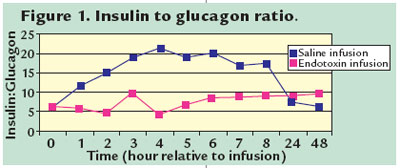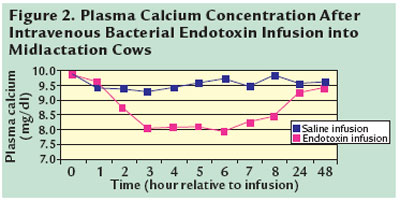Stop poor health in its tracks
Published: November 18, 2008
By: Cornell University PRO-DAIRY
Most dairy producers know that a cow with one health disorder is more likely to have other health problems. For instance, a cow with mastitis has an increased risk of getting a metabolic disorder such as milk fever. The reverse is also true: Cows with milk fever have an increased risk of mastitis.
Susceptibility to multiple health problems is particularly common during the transition period. Research is just beginning to explain why.
To understand how one health disorder might impact the occurrence of another, let’s look at bacterial mastitis. Leukocytes – or white blood cells – of the immune system can detect and destroy bacteria that gain entry to the mammary gland. But when bacteria outnumber leukocytes, or leukocyte function is impaired, bacteria can survive and infect the tissue.
The transition period is a prime time for decreased immune function, known as immunosuppression. One explanation is that the onset of lactation suppresses immunity. According to this theory, energy deficiency
during early lactation could hamper leukocytes functioning, thus leading to infection.
An experiment at the USDA National Animal Disease Center sheds more light on what contributes to immunosuppression at transition. Cows that could not lactate after a mastectomy still developed some aspects of immunosuppression around the time of calving. This indicates that while lack of energy may be partially responsible, factors independent of it and of lactation also contribute to immunosuppression.
Band-Aids don’t work
Realizing the importance of immune function, producers often attempt to enhance it with nutrient supplements, sometimes believing the more the better. Zinc, copper, selenium, vitamin E and other nutrients in highly available forms have enhanced immune performance in dairy cattle compared to animals deficient in those nutrients. But controlled research has shown that supplementing these and other nutrients in excess of National Research Council (NRC) requirements is rarely beneficial.
Instead of taking a Band-Aid approach, producers will improve herd health by paying attention to the basics of transition cow care. These examples show why.
THE SCIENCE: Ketotic blood factors decrease leukocyte function. In turn, impaired leukocyte function could contribute to immunosuppression and increase the incidence of infection in ketotic cows. Conversely, an infection when a cow is energy deficient may make her more susceptible to ketosis.
Insulin and glucagon are two hormones involved in regulating plasma glucose concentrations in blood. Work in the Overton laboratory found that when the immune system was activated by bacterial endotoxin infusion, the levels of these hormones relative to each other (Figure 1) were altered. This hormonal change may affect normal glucose metabolism and increase the incidence of ketosis.
THE BASICS. These data confirm the importance of well-balanced, energy-dense rations and maximum intake for transition cows. Practices such as bunk management, grouping strategies and cow comfort are important.

THE SCIENCE. There’s a correlation between abnormal calcium metabolism (milk fever) and the risk of mastitis. Research shows that factors involved with calcium metabolism may contribute to immunosuppression. Low plasma calcium and high plasma vitamin D, typical at calving and during milk fever, may combine to depress leukocyte function and impair immunity. These factors may combine to increase the risk of infection when a cow has milk fever. On the other hand, immune activation of cows in research trials decreased plasma calcium
(Figure 2), phosphorus and vitamin D concentrations. Therefore, prefresh mastitis or other infections when plasma calcium is marginal, such as at calving, may contribute to the development of milk fever.
THE BASICS. Minimizing exposure to environmental pathogens and attention to good calving protocols help limit infectious diseases. Sound prefresh rations minimize the incidence of milk fever. Herds with persistent hypocalcemia due to high potassium forages may need anionic salts added to the prefresh ration.

THE SCIENCE. Stress compromises immune function by causing the release of hormones such as cortisol that are potent immunosuppressants. Stress also often leads to depressed feed intake, which exacerbates energy deficiency and increases the risk of health disorders.
THE BASICS. To improve immune function, minimize stress through proper grouping strategies, well-designed stalls, limited overcrowding, good ventilation and adequate bedding. Minimizing factors that cause stress, particularly during the transition period, can increase start-up milk and decrease disease.
Manage the basics
To successfully transition healthy animals through the first few weeks of lactation, stick to these basics:
■ High quality close-up dry cow programs minimize the incidence of milk fever and ketosis. Proper trace-mineral and vitamin nutrition prevents deficiency of these nutrients.
■ Excellent feed and bunk management maximizes feed intake and nutrient delivery, minimizing energy and nutrient deficiency.
■ Well-designed facilities and grouping strategies enhance feed intake, minimize exposure to environmental pathogens andmaximize cow comfort, thus limiting stress.
By Matthew R. Waldron, Bill Stone and Tom Overton
The Manager newsletter - Northeast Dairy Business
Cornell University PRO-DAIRY
■ Matthew Waldron is a Ph.D. student in animal science at Cornell University.
■ Tom Overton is assistant professor of dairy management and nutrition at Cornell’s Department of Animal Science.
■ Bill Stone, a veterinarian, is a member of the PRO-DAIRY staff at Cornell.
Source
Cornell University PRO-DAIRY Related topics:
Recommend
Comment
Share

Would you like to discuss another topic? Create a new post to engage with experts in the community.






